Immerse yourself in Burgos's vibrant flavors and uncover hidden culinary gems with our expert insider guides. Plan an unforgettable trip today!
Read more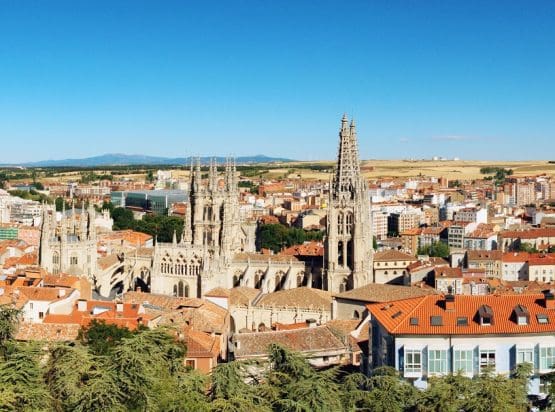
EXPLORE ALL OUR CASTILLA Y LEON WINE REGIONS GUIDE
Last updated: October 11, 2024
Castilla y Leon was a late starter to the modern wine renaissance; Ribera del Duero, for example, was not awarded DO (appellation) status until 1982. Yet the region has more than made up for lost time.
Today the arid plains of ‘old castile’ play host to a number of emerging DOs that are starting to find their feet. Chief among them is D.O. Arribes, situated close to the border with Portugal. It has long been associated with the esoteric Juan Garcia variety, which produces concentrated and aromatic red wines that occasionally suffered from rusticity in the past.
However, the range of varieties planted in Arribes has increased significantly over the past decade, while real investment has raised standards of viticulture and winemaking. Take note: Arribes is on the up.
Discover more about Spanish Wine
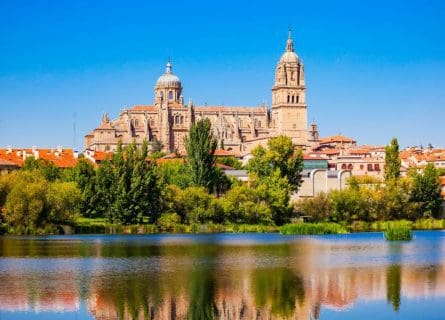
The history of Castilla y Leon is as rich – and spicy – as the potent reds of Cigales and Ribera del Duero. Some historians believe that the Phoenicians planted the region’s first vines, a civilization that colonized Western Europe from their base in the Middle East. Other experts, however, believe that the Romans were responsible for bringing wine growing to Castilla y Leon following their conquest of the Iberian Peninsula in the 3rd century BC.
The Romans controlled Spain for over five centuries, planting vines in every corner of the peninsula. Some of their most striking pieces of architecture – such as the Aqueduct of Segovia – can still be viewed today.
Yet the vastness of the empire eventually proved to be its undoing. Surrounded by bellicose tribes in all directions, Rome’s hegemony collapsed in the 5th century following a successful campaign led by the Visigothic King Alaric I. In 476, the entire Western Empire fell into chaos: Spain’s vast mineral wealth became a hotly contested commodity. The Hispano-Roman nobility and the emerging Christian clergy aided the long-haired Visigoths in establishing a power base in Toletum (Toledo).
However, the Visigoths were prone to internecine conflicts and family feuds; when the Moors invaded Spain in 711, they found a rotten and disorganized state. Sweeping across the peninsula with a force of Arab and Berber mercenaries, the Franks only defeated the Muslims in the city of Poitiers in 732.
Nevertheless, Castilla y Leon was under Muslim domination in the early 8th century. As a key province in the kingdom of “Al Andalus,” its inhabitants benefited from significant advancements in engineering, medicine, and agricultural methods.
Meanwhile, the small northern Christian states were planning a rebellion. Castile (Castilla), originally a small province within the kingdom of Leon, emerged as a powerful force in the 11th century. After a bloody succession of fierce battles, the Christian forces of Castile and Aragon reconquered most of the Iberian Peninsula.
Age of Discovery
In 1492, Castilian armies under the command of Isabel and Fernando took Grenada, the last Muslim stronghold of Boabdil. That same year, the Catholic Monarchs granted Christopher Columbus funds for a voyage across the Atlantic in search of a trade route to the Orient. His subsequent discovery of the Americas opened up a whole new hemisphere of opportunity for Spain, generating vast wealth for the crown.
Unfortunately, the Habsburg monarchs spent much of the new gold on European wars, wasting any chance of the nation becoming an early industrial power. However, under the Bourbon dynasty, Spain made a limited recovery in the 1700s. New industries, such as Seville’s tobacco factory, opened, and artistic expression flourished in the capital Madrid.
Sadly, the phylloxera louse, which spread to all corners of the peninsula in the late 1800s, devastated the country’s wine-growing industry.
Revitalization
n the mid-20th century, poor farmers abandoned many vineyards in Castilla Y Leon as they emigrated to the US and northern Europe. Things only really improved in the 1980s, as EU grants and private capital revitalized the vineyards of the meseta. Arribes became one of the newest appellations to grace the vineyards of Castilla Y Leon when it was created in 2007. The progress made since that time has been remarkable.
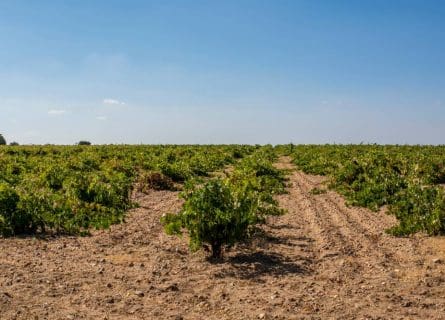
The vineyards of Arribes are located within touching distance of the Portuguese border, west of the city of Zamora. The etymology of the DO title is the Latin phrase ad ripa, which translates as ‘on the banks’. It is very apt: vineyards flank both sides of the Douro River as it winds towards Portugal.
Indeed, the landscape is among the most beautiful in Castilla y Leon, with ochre-colored plains revealing steep terraces planted to vines that slope down towards the river banks. The local growing conditions are most advantageous as infertile soils prevent vigor and ensure that the yield is seldom high in this part of northwestern Spain.
The terroir comprises shallow, sandy soils, with metamorphic rocks covering the upper layer. These poor soils encourage vine roots to dig deep in search of moisture – a scarce commodity in the summer months. Indeed, temperatures routinely exceed 95 degrees in July and August, while winters are long and cold.
Elevation and Old Vines
But, like other hot-climate regions in Spain, elevation offers some respite from the heat—Hurrah for diurnal temperature variation (a significant difference between day and evening temperature). The temperature drops as late afternoon turns to dusk, and the vine’s metabolism slows. Thus, ripening occurs slower, and acidity is not lost in the quest for phenolic ripeness.
Yet the region’s abundance of old bush vines can be relied upon to yield smaller berries of concentrated fruit. In this climate, under-ripe and ‘green’ tannins seldom occur.
For many aficionados of the esoteric and niche, Juan Garcia is one of Spain’s most exciting grapes. Indigenous to Arribes is rarely seen outside the appellation boundaries, despite the global popularity of varieties like Tempranillo. Yet there is much to admire in this obscure viticultural treasure, which is sometimes blended with small amounts of Bruñal (another style shrouded in obscurity!) and Rufete.
Diversity of Juan Garcia
At its best, Juan Garcia produces medium-bodied and spicy wines with a striking bouquet that includes detectable notes of licorice, red berries, woodsmoke, and thyme. It is joined by several red blends and varietal wines made in the DO, typically involving Tempranillo, Garnacha Tinta, and Mencia. Here, over 85% of all wines produced are red, featuring an extremely diverse range of styles including oak-aged Juan Garcia, balsamic Tempranillo blends, floral Mencia, and pungent Grenache.
Therefore, it isn’t easy to generalize about winemaking methods, as they vary considerably from producer to producer and variety. As elsewhere, the DO classifies wines according to the length of aging before release, with Crianza, Reserva, and Gran Reservas priced in ascending order.
Blancos and Rosados
Arribes Blanco is also worth seeking out. Although the reds dwarf the overall volumes, the DO produces an increasing amount of very fine white, often based on 100% Malvasia. However, Verdejo and/or Albillo occasionally make it into the blend. The local expression of Malvasia exhibits an exotic perfume, a heady mix of floral aromas, and more savory, bitter notes, for which it is noted.
Local rosados (rosés) are fruit-forward and very aromatic, typically containing a large dollop of Garnacha Tinta. Like the Arribes whites, it is becoming increasingly popular as modern consumers drink more chilled beverages and less red.
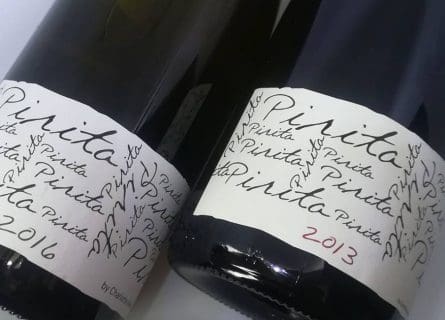
Arribes is a quintessential Spanish revival story: the acreage shrank dramatically in the 1900s as the emerging generation left to pursue careers in the major cities after the local economy stagnated. However, outside investors and previous owners’ relatives made their way to Arribes in the 20th century, attracted by the spectacular landscape and unique terroir.
Today, the DO is a niche player in Castilla y Leon, with less than 20 wineries and 400 hectares under vine. Yet, it is one of the wider region’s biggest success stories. It has numerous strengths: the regulatory council is progressive and quality-focused; therefore, it has the buy-in of every producer in the zone. Moreover, some genuinely exceptional oenologists work in Arribes, not least Charlotte Allen and Thyge Benned Jensen.
Exceptional oenologists
Allen is credited with turning an ailing nightclub into a thriving boutique winery! Visiting the area in the early 2000s, it was love at first sight for this pioneering winemaker; installing fermentation tanks on the former dance floor, Allen made her first vintage in 2007. The approach is very minimalist at Bodega AlmaRoja, with sulfur kept to an absolute minimum. As a result, her wines show great purity and terroir character and are among the best in the appellation.
Meanwhile, the slower pace of life in Castilla y Leon lured Thyge Benned Jensen (Danish) away from a career in management. Arriving in 2016, Jensen purchased just over 6 hectares of vineyards in the DO, renting some additional land planted to very old vines. Bucking the trend, the Danish superstar picks very early and includes many stems in the fermentation, producing very fragrant and fresh wines that showcase moderate alcohol, great finesse, and grippy tannins.
International Recognition
Moreover, thanks to the hard work of the Consejo Regulador, these beautiful wines are starting to find an audience abroad. Today, producers send roughly 25 percent of all production to diverse markets such as the US, Mexico, China, and Ireland; hip sommeliers and their trend-conscious customers are getting excited about these delicious wines. After decades in the doldrums, Arribes is back!
Exploring Albillo: Spain's Versatile Wine Grape in Ribera del Duero, Madrid, and Galicia. Uncover the Diversity of this Remarkable Varietal.
Find out moreMalvasia Bianca, a historical grape from Greece, now thrives in Sicily and the Aeolian Islands, producing unique sweet wines.
Find out moreUnveiling Verdejo: Spain's Rueda Wine Region's Prized White Grape. Explore the Crispness and Lightness of this Dry White Varietal.
Find out moreBruñal is a dark-skinned wine grape native to northwest Spain's Arribes region, known for its low yield. It is often used in blends alongside more prominent varieties like Juan García, Rufete, Tempranillo, and Garnacha for red and rosé wine production. The resulting full-bodied wines offer a balanced mix of red and dark fruits with notable tannin and acidity.
Juan García is a red Spanish wine grape grown in the Arribes region near the Portuguese border. It is often blended with other red grapes, particularly Tempranillo. The berries of Juan García are known for their brilliant purple color when fully ripe, and they are used to produce aromatic, light- to medium-bodied wines. It is also known by the synonym "Negreda."
Garnacha: Spain's Red Gem. Akin to Pinot Noir, it bridges terroir and winemaking, crafting captivating expressions.
Find out moreUnearth Mencía: Spain's captivating red gem. Original and alluring, it emerges from the shadows, captivating wine enthusiasts worldwide.
Find out moreRufete, also known as Tinta Pinheira, is a dark-skinned, late-ripening grape variety grown in northern Portugal, particularly in the Douro, Dao, and Beira Interior regions. In the northwestern Spanish Region of Castilla y Leon, Rufete is used for red and rosé wines, often complementing the local favorite grape, Juan Garcia. The wines made from Rufete are full-bodied with flavors of plums and earthy undertones. Rufete wines have ample tannins and good acidity, making them suitable for long aging.
Discover Tempranillo: Spain's iconic red grape. From Ribera del Duero to Toro, it yields concentrated wines. Explore its synonyms and unleash its prowess.
Find out moreVisitors may need time to adjust to the Spanish culinary timetable: in Zamora’s restaurants, people often eat the evening meal, ‘la cena,’ as late as 10 pm. But this is one part of the day you don’t want to miss! Expect succulent ham, exquisite game, meltingly tender lamb chops (chuletas), and an incredible array of tapas in the city’s lively bars.
Some of the best tapas are amazingly simple: for most Spaniards, there’s no more mouthwatering prospect than a few thin, velvety slices of Jamon de Bellota, made from swine fed on acorns. Heaven with a glass of Juan Garcia.
Guide to the Gastronomy of Castilla y Leon: Read more

Immerse yourself in Burgos's vibrant flavors and uncover hidden culinary gems with our expert insider guides. Plan an unforgettable trip today!
Read more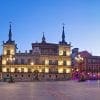
Immerse yourself in León's vibrant flavors and uncover hidden culinary gems with our expert insider guides. Plan an unforgettable trip today!
Read more
Immerse yourself in Salamanca's vibrant flavors and uncover hidden culinary gems with our expert insider guides. Plan an unforgettable trip today!
Read more
Immerse yourself in Segovia's vibrant flavors and uncover hidden culinary gems with our expert insider guides. Plan an unforgettable trip today!
Read moreIf you would like us to customize an exclusive luxury tour, contact us and let us know your travel plans. We offer luxury food and wine tours for private groups of a mininium two guests. In addition, all of our private, chauffeured tours are available year-round upon request.

